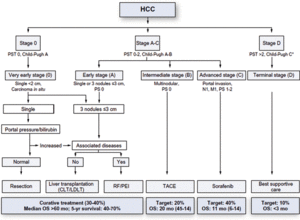Liver cancer
Hepatocellular carcinoma (HCC) is the most common histological type of liver cancer. It’s mostly a disease of older men. In almost all cases it develops in an already cirrhotic liver, so the risk factors for HCC are the same as those for cirrhosis.
The incidence of HCC is increasing. Due to the long asymptomatic period, most cases are irresectable at presentation. This gives it a poor prognosis, with a 5-year survival of 30 – 50%.
Etiology
80% of HCC are preceded by cirrhosis, so the risk factors for HCC are similar to those of cirrhosis. However, some risk factors which are independent of cirrhosis are known:
Common causes:
- Chronic HBV or HCV infection
- Metabolic associated fatty liver disease
- Alcoholic liver disease
- Aflatoxin (rare outside the developing world)
Rare causes:
- Overuse of hepatotoxic drugs like paracetamol
- Haemochromatosis
- Autoimmune hepatitis
- Alpha-1-antitrypsin deficiency
- Wilson disease
- Hepatic adenoma
Pathology
HCC develops from a dysplastic nodule in a cirrhotic liver. This nodule is a precancerous lesion that can be visualized on ultrasound.
Hepatitis B may incorporate the HBsAg into the host genome. Hepatitis C has no such capacity. Both viruses increase cancer risk due to the chronic inflammation and high cell turnover they cause.
Aflatoxin causes a very characteristic mutation in the p53 gene called a signature mutation. If this mutation is present in an HCC it’s certain that the etiology was aflatoxin.
A special form of HCC called fibrolamellar HCC is very rare. Only 200 new cases are diagnosed every year. This type of HCC develops in young adults without cirrhosis or other risk factors for HCC.
Clinical features
The tumour itself is usually asymptomatic, but the patient usually has symptoms from the underlying disease (cirrhosis or hepatitis), like ascites and jaundice. Constitutional cancer symptoms like weight loss, weakness, abdominal pain may be present but may also be caused by the underlying disease.
Diagnosis and evaluation
Patients at high risk for HCC (cirrhosis of any cause, chronic hep B) should be screened regularly for HCC. Screening involves measuring abdominal ultrasound and AFP levels. Focal lesions in a cirrhotic liver are primary liver cancer until proven otherwise. AFP is elevated only in 50% of cases, in which case the level correlates with the tumour size.
Contrast CT or MR confirms the diagnosis and shows any extrahepatic spread. Typical features on imaging include early contrast uptake, “washout”, and vascular spread.
Liver biopsy is often not needed as the definitive diagnosis can be made with imaging, and biopsy carries a risk of bleeding and tumour spread.
Staging
The Barcelona Clinic Liver Cancer (BCLC) staging is the most frequently used staging system, and at least the one preferred in POTE. The Child-Pugh score and ECOG are important in determining the BCLC stage.
The Child-Pugh score involves multiple parameters that reflect liver function (bilirubin, albumin, PTT, INR, etc.) and classifies the function as Child-Pugh A, B, or C, where A is good liver function and C is poor liver function.
The BCLC staging determines which stage the disease is in, based on the TNM staging, ECOG, and Child-Pugh score:
- Very early stage (stage 0)
- Early stage (stage A)
- Intermediate stage (stage B)
- Advanced stage (stage C)
- Terminal stage (stage D)
Notably, a Child-Pugh C is BCLC terminal stage regardless of the TNM and ECOG features.
The so-called Milan criteria are used to evaluate whether the patient is a candidate for liver transplant or not. The Milan criteria are fulfilled if there is either a single tumour not > 5 cm, or up to 3 tumours, none of which are > 3 cm. There must also be no vascular invasion or extrahepatic spread.
Treatment

Generally, only BCLC stages 0 and A are curable. Curative modalities include surgical resection, liver transplantation, as well as local ablative techniques. The choice of modality depends on the BCLC stage. For terminal stage (D), no tumor-directed therapy is indicated; only palliative care is used.
Surgery
Surgical resection, preferably laparoscopically, is an option for very early or early stage liver cancer. Anatomical resection refers to resection which respects segmental and lobar anatomy. This may include segmentectomy (or bisegmentectomy or trisegmentectomy), hemihepatectomy, or sectionectomy. Atypical resection refers to resection which does not respect the liver anatomy.
Liver transplantation
Liver transplantation is a treatment option for early stage tumour. Liver transplantation is only considered if the Milan criteria are fulfilled.
Local ablation
Local ablation of the tumour, by radiofrequency or microwave ablation, or percutaneous ethanol injection, may be curative options in intermediate stage tumours.
TACE
Transarterial chemo-embolisation (TACE) is a minimally invasive technique which is the standard of care for patients with intermediate stage HCC. It involves intra-arterial injection of an emulsion of oil and a chemotherapeutic drug followed by embolisation of the blood vessel. The theory is that the combination of the chemotherapeutic drug and the ischaemia kills the cancer cells. TACE can not be used for cure and is therefore used with palliative intent.
Sorafenib
Sorafenib is a small molecule protein kinase inhibitor which is indicated for advanced stage HCC. It inhibits a variety of protein kinases. Sorafenib may be used as palliation in advanced stage HCC.
